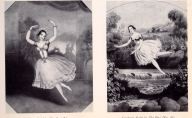 19th c. Escapism
19th c. Escapism
The decades of the late-eighteenth and the early-nineteenth centuries had been tumultuous ones in Europe. The French Revolution of 1789, followed by the Terror, the Napoleonic Wars and the Revolution of 1830 in Paris, had left Europe disillusioned and war-wearied. This coupled with the Industrial Revolution, which brought about its own series of upheavals and innovations, created the desire for an escape from the everyday world (Artz 1934). Reflected in the painting, literature, and theatre of the time, the ballet stage also attempted to provide diversion from the realities of the outside world. This desire for escapism and the role of dance in its realization are reflected in the writings of Janin (Chapman 1997):
"
[Dance] is one of our least demanding pleasures, a form of relaxation
at the service of idle and tired minds. Describe something to me that is
sillier
and at the same time more entertaining than a ballet! Ballet is the pleasure
of the minds that have toiled all day…" (p. 224).